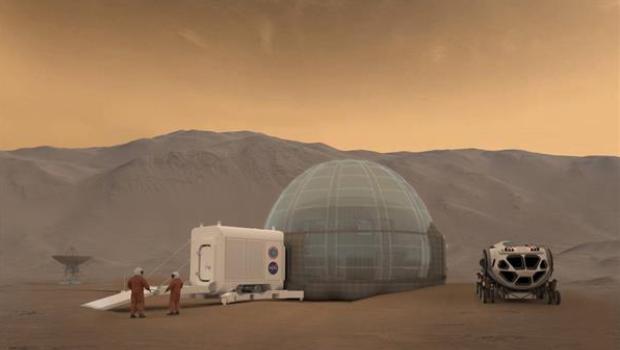The NASA experts along with a group of designers and architects exposed the Mars Ice Dome which is known as an ice-based habitat which will be used at Mars.
Since, the surface of Mars has outrageous temperatures, and on the grounds that the Red Planet’s air does not give sufficient assurance from high-vitality radiation, the principal human pilgrims on the planet will require vigorous and successful asylums that will shield them from the wild conditions. Notwithstanding, building such an asylum postures issues: since space explorers can just take a limited measure of assets on the inevitable voyage from Earth, the development can’t be made of any old material. Rather, our Mars colonizers should make some utilization of whatever they can discover on the planet—including water.
It is declaration to the ground breaking nature of NASA that its most up to date Mars environment idea is really an improvement of a thought set forward by an opposition champ in 2015. Mists Architecture Office, the organization behind the thought, won $25,000 for outlining a 3D printable Ice House for the 3D Printed Habitat Challenge. That idea included 3D printing ice, which can be found on Mars, and keeping it contained inside a straightforward ETFE layer. NASA was so awed with the possibility that it not just granted Clouds AO with the fabulous prize, however has likewise started to build up the thought assist—as the Mars Ice Dome.
A gathering of NASA specialists, in a joint effort with Clouds AO and various creators and modelers, as of late began work at NASA’s Langley Research Center in Hampton, Virginia, where they have been building up the Mars Ice Dome into an achievable idea for Mars home. “Following a day committed to recognizing needs, objectives and limitations we quickly surveyed numerous insane, out of the container thoughts lastly focalized on the present Ice Home plan, which gives a sound building arrangement,” said Langley senior frameworks design Kevin Vipavetz, facilitator for the outline session.
While the doughnut formed Ice Dome could assume control over a year to be loaded with water, it could—as indicated by NASA—be developed and filled before the group even land, since robots could be sent to Mars ahead of time. Once the space travelers do arrive, the Ice Dome could then present may benefits. For one thing, hydrogen-rich water can shield galactic infinite beams, which are one of the greatest dangers to people on Mars, since they could bring about disease or intense radiation infection. Moreover, the water put away inside the 3D printed living space could conceivably be changed over to rocket fuel for the Mars Ascent Vehicle.
One of the greatest focal points of the water-based 3D printed territory is that space travelers will be shielded from astronomical beams, however, will at present get a lot of light through the translucent dividers. “The greater part of the materials we’ve chosen are translucent, so some outside light can go through and make it feel like you’re in a home and not a give in,” said Langley Mars Ice Home key agent Kevin Kempton.
Be that as it may, while sunshine will be a favorable position to those living in the territory, there were other basic contemplations that went into picking certain materials for the structure. “The materials that make up the Ice Home should withstand numerous years of utilization in the cruel Martian environment, including bright radiation, charged-molecule radiation, potentially some nuclear oxygen, perchlorates, and also tidy tempests—in spite of the fact that not as savage as in the film The Martian,” said Langley analyst Sheila Ann Thibeault.
The specialists on the Ice Dome venture are right now looking for routes in which water could be quicker extricated from Mars. At present, they imagine that it is conceivable to fill the living space at a rate of one cubic meter for every day, permitting the living space to be finished in 400 days. Assuming, in any case, they can figure out how to expand this rate, the venture could be scaled up in size.
At last, the NASA specialists, draftsmen, and creators behind the Ice Dome basically need the natural surroundings to be as valuable and agreeable as feasible for whoever has the benefit of being sent there. “Following quite a while of go in space, when you first touch base at Mars and your new home is prepared for you to move in, it will be an incredible day,” Kempton said.
